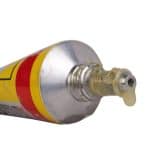Black jackets with studs have a very strong and long history. The punk jacket aesthetic is worn by all sorts of groups from bikers, to rock bands, and edgy fashion fans. If you want to learn how to turn your leather jacket into a studded jacket, keep reading as you will learn all about it in this article.
Is it safe to put studs on my leather jacket?
You will need to punch holes in your leather jacket and pierce through the leather in order to attach the studs and spikes. The metal accessories usually come with two or more prongs meant to pierce the leather and be bent inwards to keep them in place.
Temporary solutions include using glue or double-sided tape on flat-back studs but these might fall out easily or leave residue on the leather. Worse, they might even peel off the outer layer of some cheap leather jackets like cheap genuine leather jackets or faux leather jackets.

Different types of studs you can use
There are many stud styles that you can choose from. Aside from their shapes, the main difference in studs is in how they can be attached. Some studs must be glued on, while others can be fastened directly onto your leather jacket with prongs attached. Metal studs usually have prongs, while flat-backs can be made of plastic.
Normal studs
Normal studs usually come in the shape of stars, pyramids, hearts, and more. These types of studs have prongs on the back and all you need to do is poke through the leather material and fold the prongs down on the back part. You can do this by hand or using pliers so you don’t have to exert too much strength. Silver studs are the most common, but you can also find gold studs.
Spike studs
Spike studs come with fastener pieces and you can simply push the fastener through the leather jacket from the inside and place the spike on top to lock it. You will need a hammer for this. Some spike studs also have screw-on fasteners which are easier to attach without needing to hammer it on.
Flat-backed studs
Studs with flat backs are common and all you need is a bonding glue to attach them to your leather jacket. We don’t recommend using hot glue for these types of studs because they won’t stick to the leather material properly.
How to stud your leather jacket
Studding with prongs
This is a very permanent studding method. With pronged studs, there is no going back as you will be piercing the leather to attach the studs.
Things you will need:
- Studs with prongs
- Stitching awl
- 1 tooth leather punch
- Thimble
- Pliers or hammer
- Piece of rubber or cloth
- Piece of sacrificial wood
Method:
- Prepare all your materials and use a thimble to avoid accidentally poking yourself with the awl or prongs.
- Mark the spots where you want to attach your studs by making indents on your leather jacket. You can do this by lightly pressing the prongs on the back of the studs to your leather material to create an indentation.
- Use the stitching awl to make tiny slits on your leather jacket– the slits should be smaller than the prongs so they won’t move around. Don’t just poke through it directly because you are risking tearing the fibers more than necessary.
- Hold your leather jacket firmly or place it on top of a piece of wood for this step. Push the prongs of the studs inward going through the slits.
- Turn your leather jacket inside out and bend the prongs inward to secure and lock the stud into place. You can use pliers for this method to avoid hurting your fingers.
- Remember that the farther you bend the prongs, the tighter they will hold on to your leather jacket. This is what you should aim for since studs are not meant to be loose in the first place.
Alternate method:
If your leather jacket is too thick or you are afraid that you may create slits too big with a craft knife, you may also use pliers or a hammer and a leather punch to stud your jacket.
- Lay your jacket flat on a hard surface
- Put the sacrificial piece of wood under the area you want to stud to avoid piercing anything underneath.
- Place a piece of rubber over the stud to prevent scratching it. You may also put the rubber over the hammer instead.
- Hammer gently but firmly onto the stud. It shouldn’t take you more than 3 hammer blows to go through the material.
- If you have a single-tooth leather punch, you can also use that to create the hole for the stud to go through.
- If you are using pliers, put the rubber on the teeth to prevent it from scratching the leather or the studs.
- Squeeze the handle firmly until you feel the prongs go through.
- Bend the prongs together to secure it. You may also softly hammer the prongs shut.
Tips and extra information:
- If you do not have a stitching awl used for leather crafting, you may also use a pen knife or a craft knife to create the small slit required for the prongs to fit through.
Studding using bonding glue or double-sided tape
Bonding glue or cyanoacrylate is a permanent solution and will most likely take some leather with it if you try to take it off. There are cyanoacrylate removers that work well, but they might ruin the leather’s surface or discolor it. Double-sided tape is very temporary and will most likely fall off after a day of use.
You must use flat-back studs for this. Simply apply the double-sided tape to the stud and peel off the other side and attach it to the jacket. This will be a very tedious process as removing the other side of the tape can be annoying.
If you decide to use bonding glue, it is best to glue it one at a time as bonding glue dries quickly. You may use a needle to apply the glue in small amounts. It is also best to use gloves if you do not have glue remover as you may end up gluing your fingers together.
Conclusion
Pre-studded leather jackets can cost way too much in retail stores, so if you want to save some bucks and level up your plain old leather jacket, you can just DIY at home. Different types of studs can cost $5 for a bag with around 100 pieces and the great thing about it is that you have complete freedom on how you can style your jacket.
These techniques can also be used to make studded leather pants, so go wild!
FAQ
How do you stud leather boots?
Leather boots are made of thicker material than leather jackets so you will need tools such as a hammer or a plier. The process is pretty much the same as we mentioned above, but you need to take extra precautions on where to place the studs so as not to hurt your feet when wearing them for long periods.








